|
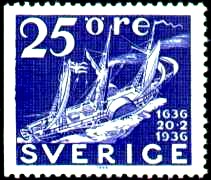
|
Maritime Topics On Stamps :
The Beginning of Steam Shipping with Paddle Wheels!
|
The Swedish paddle steamer 'Constitutionen',
build 1822 at Karlskrona for mail delivery.
|
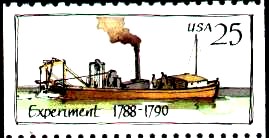
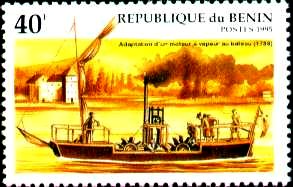
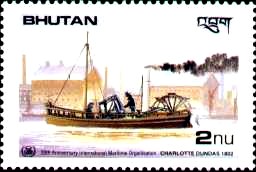
|
Some facts from the beginning of steamshipping:
- In 130 B.C. first experiments around the mechanical use of steam
were conducted at Alexandria, Egypt.
- In 1690 the French Papin succeeded in moving a piston by steam
only. In 1707 he built a boat with paddle wheels and tested it on the
river Fulda.
- The British Jonathan Hull developed a steamship and registered the
first steamship patent. This was in the year 1735.
- In 1769 James Watt announced to register his steam engine for a patent.
- From 1772 to 1774 the Comte Joseph B. d'Auxiron built a
steamboat. During the first test trip the boat sank.
- In 1775 the French J.C. Perrier constructed a steamboat but the power of
the engine was not sufficient to travel the river Seine up-stream.
- From 1778 to 1783 the Marquis Claude-Francois Dorothee Jouffroy
d'Abbans had two steamboats built. As with Perrier the first boat's
engine was not strong enough, but the second one became the first succesful power driven vessel.
Her name was 'Pyroscaphe' and she had a lenght of 45m. During a test
offshore Lyon she was steaming against the stream for 15 minutes.
- In 1787 the American James Rumsey travelled up the river Potomac
at a speed of 6.5 knots.
- From 1787 to 1790 the American John Fitch and the German immigrant
Johann Voigt built several steamboats. During the first disappointing
testing trips on the river Delaware they reached a speed of 3kn, but
even the coaches ashore went faster. After improvements the
'Perseverance' was able to travel at 5 knots. Then they constructed
the 'Experiment' (see the stamp, with a stern paddle.) and the
'Thornton' pushing the maximum speed to 8 knots. Although the test
ships carried around 30 passengers, steamboating was very unprofitable
in those days.
- Meanwhile in the UK, in 1788 the British Patrick Miller and
William Symington built a steamboat which was able to move at 5 knots
(using two paddle-wheels, see the stamp in the middle). A few years
later, in 1801 Symington build a tug for Lord Dundas bearing the name
'Charlotte Dundas' (see the stamp from Bhutan). It was a stern-
wheeler with an engine power of 10 HP. During a test trip she was
able to tow two barges of 70 tons for as far as 31 km.
|
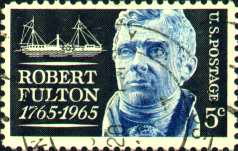
|
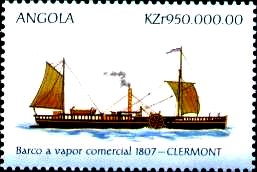
| |
Robert Fulton built his first two steamboats in 1803 in France. The
first boat was destroyed by a heavy storm, but the second one became
more successful. Nevertheless the French officials were not convinced
and Fulton returned back to America. In 1807 he built the 'The
Steamboat'. The ship had a length of 142', beam 14', draft 4', 100
tons and the engine 20 HP. During the test trip the boat ran 4.5 knots
and Fulton immediately started the first passenger voyages. After a
major overhaul in 1808 the ship was able to carry 100 passengers. Her
name was now 'North River Steamboat of Clermont', short 'Clermont'.
She became the first commercially successful
steamship. Later on Fulton constructed several
steamships more and even a man of war (see below).
|
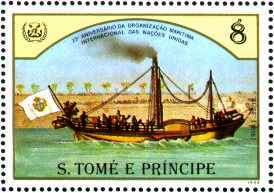
|
In 1816 a company for passenger trips on the river Seine was founded
in Paris. The company used the steamboat 'Margery', purchased in
England, which was build at Dumbarton in 1814. She had an engine with
10 HP installed, reaching a maximum speed of up to 6 knots. She was
later renamed 'Elise' (see left). During March 1816 the first crossing of the English Channel from Newhaven to Le Havre took place.
|
|
On the 24th of May, 1819 the 'Savannah' left her homeport Savannah and
reached the port of Liverpool on the 20th of June, 27 days later. It
was the first crossing of the Atlantic Ocean of an engine-powered ship. During the voyage the engine
only ran for 85 hours. The other time the ship was sailing. Upon
reaching the Irish coast the vessel blew out a cloud of smoke and was
at first reported as a burning ship. The measurements were: Lenght 109',
beam 26', draft 13', engine 90HP, speed 4kn during calm sea.
|
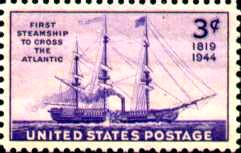
|
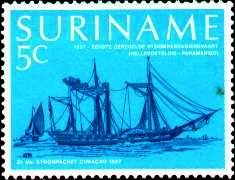
|
In 1826 the 'Curacao' was built at Dover. At first she bore the name
'Calpe', but was renamed when she was bought by the Dutch navy. The
ship had a length of 177', two engines totalling 100 HP and 239 tons.
She was the first ship to cross the Atlantic Ocean
from Europe to South America. The voyage started
at Hellevoetsluis near Rotterdam on the 26th of April 1827 and ended
at Panamaribo on the 24th of May. During this time the 'Curacao' ran
for 11 days using the engine. The paddle had to be changed several
times and the boiler was leaking. All in all the 'Curacao' conducted
three Atlantic passages.
|
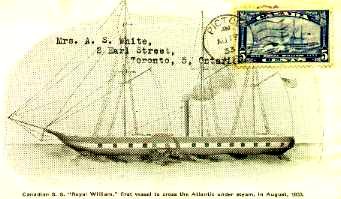
| |
On August 18th, 1833, the 'S.S. Royal William' started at Pictou, Canada and
docked at London 25 days later, thus becoming the first boat to cross the
Atlantic ocean under steam for the entire distance.
Every four days the
steam boilers were cleaned from salt. During this time, the engine had to be
stopped and sails were set. The measurements of the 'Royal William': 363
tons, length 177', beam 28', engine 300 HP, average speed 5kn, built
1831 in Canada.
|
The 'Blue Riband' was a famous
trophy of the North Atlantic. Nobody cared to officially write down
the rules, as the 'unwritten laws' were fully sufficient:
- The ship had to be a passenger liner.
- The ship had to travel from east to west starting in Europe and
finishing in North America.
- The ship with the highest average speed wins.
|
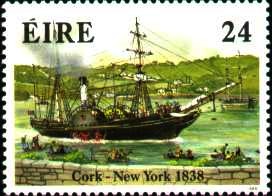
|
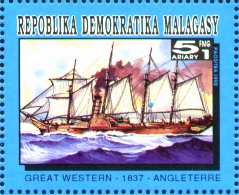
| |
On the left stamp you can see the 'Sirius'. She was built in 1837 at
Leith, with a length of 200' and 703 tons. She reached 7.5 knots using
her 600 HP double-cylinder engine. To the right you can see the 'Great
Western'. She was built in 1837, too, at Bristol with a length of 236'
and 1340 tons. The 'Great Western' used a slightly stronger double-cylinder
engine with 750 HP enabling her to make 8.5 knots. It took 18
days for the 'Sirius' of the British American Steam Navigation Company
to reach Sandy Hook/New York from Cork/Queenstown, resulting in an
average speed of 8.03 knots. This happened during April 1838. The
'Great Western' of the Great Western Steamship Company left four days
later from Avonmouth and reached New York only one day later than the
'Sirius'. She needed about 15 days for the voyage (average speed of
8.66 knots). In those days the 'Blue Riband' was still unknown, but
both ships are later listed in the history books of
all Blue Riband voyages as the two first record
holders.
|
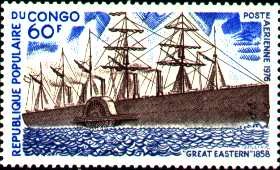
|
The 'Great Eastern' was built from 1857 to 1859, constructed by
Isambard Kingdom Brunel, who was also involved with the 'Great
Western', as well. She had a length of 689', beam 85', draft 30',
engine power 8300 HP, two side-wheel paddles, one screw, maximum speed
13.5 knots. She was the largest ship built in those
times, but was always plagued by misfortune. When
she was launched, her hull became stuck. On the test trip six persons
were killed by an exploding boiler. She had room for 3000 passengers
but carried only 43 during the first Atlantic voyage.
| |
Her owners
changed, the ship was overhauled and used as a cable ship. The ship
never became profitable. The reason was simple: The 'Great Eastern' was
too large for those days. She was scrapped in 1888.
|
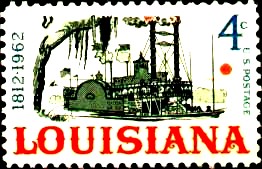
|
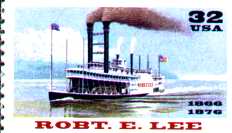
| |
Steamshipping on the Mississippi started in 1811 with a voyage of the
'New Orleans'. In 1816 the 'George Washington' was built. She was the
prototype for over 5000 Mississippi steamboats to follow. Their length
varied from 190' to 320', the beam 32' to 40' and a draft of max. 6'.
Normally the wheel was placed aft to protect it against floating
debris. On the Louisiana stamp you can see the standard construction.
To the right the 'Robert E. Lee', a side wheeler, which was able to
run faster than a stern-wheeler. On the Mississippi many races took
place between rivalling steamboats at midnight. One of the most famous
races happened in 1870 between the 'Natchez' and the 'Robert. E. Lee'.
The course stretched from St. Louis to New Orleans. The 'Robert E.
Lee' won the race and got the title of 'fastest ship
on the river'.
|
|
On this part of a cover you can see the stern-wheeler 'Bonnington'.
She was built in 1911(!) in Canada. The ship was used for postal
duties on the Canadian lakes and served until 1946.
Stern-wheelers went slower than side-wheelers but
they were more economically efficient. Additionally the stern wheel
was protected against drifting debris and ice.
|
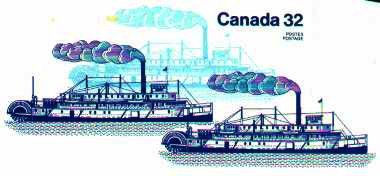
| |
In the second half
of the 19th century the age of the screw steamers began and the great
time of the paddle steamers ended.
|
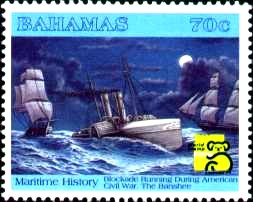
|
The first man of war with a steam engine was the 'Fulton the First',
built in 1814. She was never used since the war she has been built for
ended before her completion. Paddle steamers are not suitable for man
of wars. The wheels are a very good target, boilers were very
vulnerable and subject to explosion and fires were a deadly threat.
Nevertheless constructors tried it. They put the wheels between two
hulls as a cat and placed the boiler below the waterline. On the stamp
you can see the blockade runner 'Banshee' during the American civil
war (from 1860 to 1866). These ships had the task to carry arms and
ammunition to the besieged ports.
|
| A small ferry boat, crossing the river Congo.
|
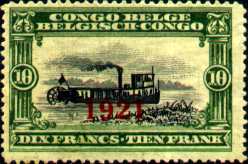
|
|